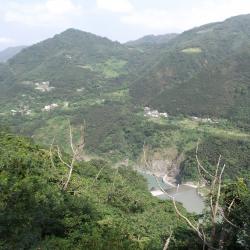Yihsing (Gihin) is located in Yisheng village, Fuxing District, Taoyuan City, about three kilometers south of Xiaowulai, on the platform or slope on the right bank of the middle reaches of Dahan River, about 400 meters above sea level. It sits opposite Gaopo across the Dahan River, and can be reached by crossing the suspension bridge from Beiheng Highway. Also known as Gihin, which means sunshine in the Atayal language. It is said that in the past, people from the Xuewunao (Sbunaw) community came and saw the sunshine, they believed that their descendants would prosper if they lived here. So, they moved to settle here and named the place Gihin. It is also said that Gihin means hillside land, grass, and leech, but none of them can be tested. Today, there are Yihsing No. 1 and Yihsing No. 2, so there are many rice fields, and bamboo and mushrooms are produced on the hillside. After the completion of the Yihsing sand-blocking dam on the Dahan River, the Yihsing Power Plant was constructed using hydraulic power.
Indigene Management
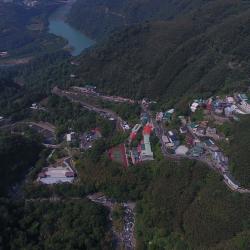
Xiayunei (Rahu’), also known as Xiao Wulai, is located in Yisheng village, Fuxing District, Taoyuan City. In the early days, it was called rahu-ulay, which means the lower half in the Atayal language. It was named after the pomelo tree at that time. There was a hot spring in the ulay stream, which was later destroyed. The upper half used to be called gramay, but today it is called ulay. In the early days of the Restoration, the place names in the Fuxing District were all translated in Hokkien. In order to identify Taipei Wulai, it was called Xiaowulai, or it was translated as Yunei, because it was located relatively downstream, so it was called Xiayunei. The Atayal language ulay means waterfall, and some people misunderstand it as hot spring. There is Yisheng Elementary School founded in 1950 in the settlement. During the Japanese occupation period, the Japanese came to manage it, and the settlements in the lower half were residents who originally lived in the upper half.
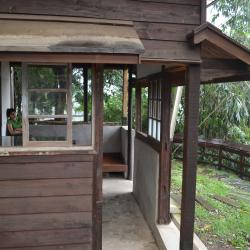
Located next to the Jiaobanshan Residence, the Jiaobanshan Camphor Storehouse was built in Showa 14 (1939). In the period of Japanese rule in the late Qing Dynasty, Taiwan's camphor production accounted for 70% of the world's total production, so it was called the "Camphor Kingdom", and Jiaobanshan was the distribution center for camphor cutting in northern Taiwan. It was to facilitate smooth transport of the camphor to Daxangkan (now Daxi), then transport it to Taipei by Dahan River, and export it to the rest of the world. In Meiji 34 (1901), the Taiwan Governor's Office Monopoly Bureau was established to include camphor-related affairs. In the 8th year of Taisho (1919), in order to strengthen control and reduce costs, the "Taiwan Camphor Manufacturing Co. Ltd." was established with a government-run and private production method. In the 9th year of the Showa era (1934), the Taiwan Governor's Office disbanded the manufacturing company and changed the manufacture of raw materials and finished products under the control of the Special Sales Bureau. After the Nationalist government moved to Taiwan in 1945, the monopoly system of camphor production was still maintained until 1967.
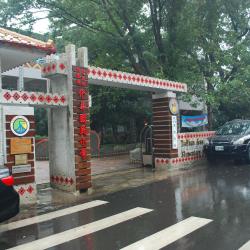
In August of Meiji 42 (1909), Jiaobanshan A-grade Indigenous Children's Education Center was established, which was the predecessor of today’s Jieshou Elementary School. In September 1946, the original national language (Japanese) workshop was merged to establish the Jiaoban National School in Jiaoban Township, Hsinchu County. In October 1949, it was renamed Jiaoban National School, Jiaoban Township, Taoyuan County. In 1954, Jiaoban Township was renamed Fuxing Township, and the school name was also changed to Taoyuan County Fuxing Township Jieshou National School. In 1957, it cooperated with the implementation of nine-year compulsory national education and was renamed Jieshou National Elementary School. Jieshou Elementary School is in a remote area. The design of the campus is based on Atayal culture. Due to the special environment, special attention is paid to the integration of multi-ethnic groups and the implementation of multi-cultural views.
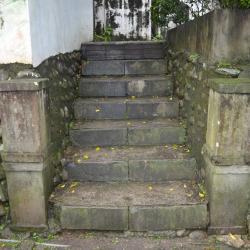
During the Japanese occupation period, the Jiaobanshan Shrine was built in Jiaobanshanshe, an indigenous community in Daxi County, Hsinchu Prefecture. It was erected on August 15, Showa 13 (1938), and the gods worshiped are the God of Harvest and Prince Kitashirakawa Yoshihisa. The original site is located near the intersection of Zhongzheng Road and Renai Road, Zerenli, Fuxing District, Taoyuan City, near the Fuxing District Library and History and Culture Center. The building structure of the shrine has been demolished after the war, and the only visible remains are the worship path that became the alleyway and four stone lantern poles.
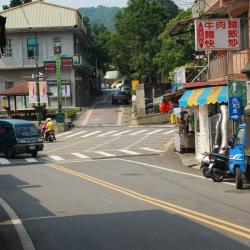
The slope in the distance was the route leading to Jiaobanshan Shrine during the Japanese occupation. The building on the left side of the slope is the Taoyuan City Fuxing District Library, and on the right is the Fuxing District History and Culture Museum. The Jiaobanshan Shrine was built in Jiaobanshanshe, an indigenous community in Daxi County, Hsinchu Prefecture. It was erected on August 15 in the 13th year of the Showa era (1938), and the deity was dedicated to the God of Harvest and Prince Kitashirakawa Yoshihisa. The original site is located near the intersection of Zhongzheng Road and Renai Road in Zerenli, Fuxing District, Taoyuan City. After the war, the shrine was demolished, and only the "poles" (the long column from the lower part of the stone lantern) of stone lanterns remain, which are now used as decoration beside the stairs. The names of the donors are still visible on the stand.
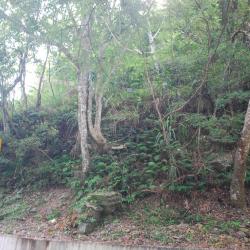
The Taman River Police Post is located on the mountain opposite the southern side of the Dahan Bridge parking lot in Fuxing District of Taoyuan City. When the construction of the Northern Cross-island Highway began in 1963, many railway bridges that were built during the Japanese occupation were demolished and reconstructed because most of the routes overlapped with the Jiaobanshan Sanxing Historic Trail. The Taman River Suspension Bridge, that was next to Taman River Police Post, was also rebuilt into the Dahan Bridge, which overlooks the narrow valley of Taman River and the Baling area.
Today, in the woods on the mountain opposite the parking lot, the remains of the stacked stones from Taman River Police Post can still be found.
The Old Laiyi Police Post is located on a wide platform above the slate houses of the Old Laiyi tribe in Laiyi Township, Pingtung County. There are relics such as iron houses, water towers, and water tanks on site. The building was set up by the Government-General in Taiwan during the Japanese occupation. In fact, there are two hamlets in the area. The larger hamlet on the southeastern side is called Chajiakavus, and the smaller hamlet on the northwestern side is called Chingasan. In the early post-war period, the tribesmen were forced to collectively relocate their villages to the current Laiyi hamlet.
To get to Old Laiyi hamlet, enter from the fork road on the 6.5 km point of Yilin Road, and you will see the stone stele of the old Jala’afus tribe at the entrance. There are still large-scale slate houses in the hamlet ruins.
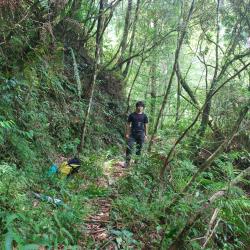
The Dazheng Police Post in Datong Township, Yilan County is located near the Mingchi Forest Recreation Area. To get there, go from the Northern Cross-island Highway, cut eastward to Fanfan Creek, then head up the Sanxing Historic Trail in Jiaobanshan, and follow the road to arrive at Dazheng Police Post and Dazheng Bridge. In fact, the Jiaobanshan Sanxing Historic Trail, which traverses the Fuxing District of Taoyuan City and Sanxing Township in Yilan County, was built in 1911 and has a total length of about 125 km. It is the earliest road excavated for Lifan (regulating Indigenes) purposes during the Japanese occupation. A total of 14 police posts were set up along the way, and Dazheng Police Post was one of them.
Today, most sections of the Jiaobanshan Sanxing Historic Trail have been replaced by the Northern Cross-island Highway.
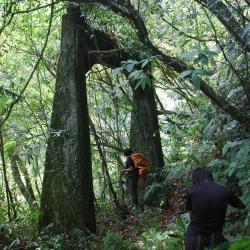
The former Dazheng Bridge, located in Datong Township, Yilan County, stood between Dazheng Police Post and Takinoue Police Post. It is an iron cable suspension bridge on the Jiaobanshan Sanxing Historic Trail that was built in 1916.
Today the bridge has been completely destroyed, leaving only the east and the west bridge tower. The end of the bridge is about 20 meters away from the valley. If you want to go to the west end of Dazheng Bridge site, you can cut eastward from the Northern Cross-island Highway near the Mingchi Forest Recreation Area to Fanfan Creek, then head up to the Sanxing Historic Trail of Jiaobanshan and follow the road to reach the Dazheng Police Post and Dazheng Bridge.
